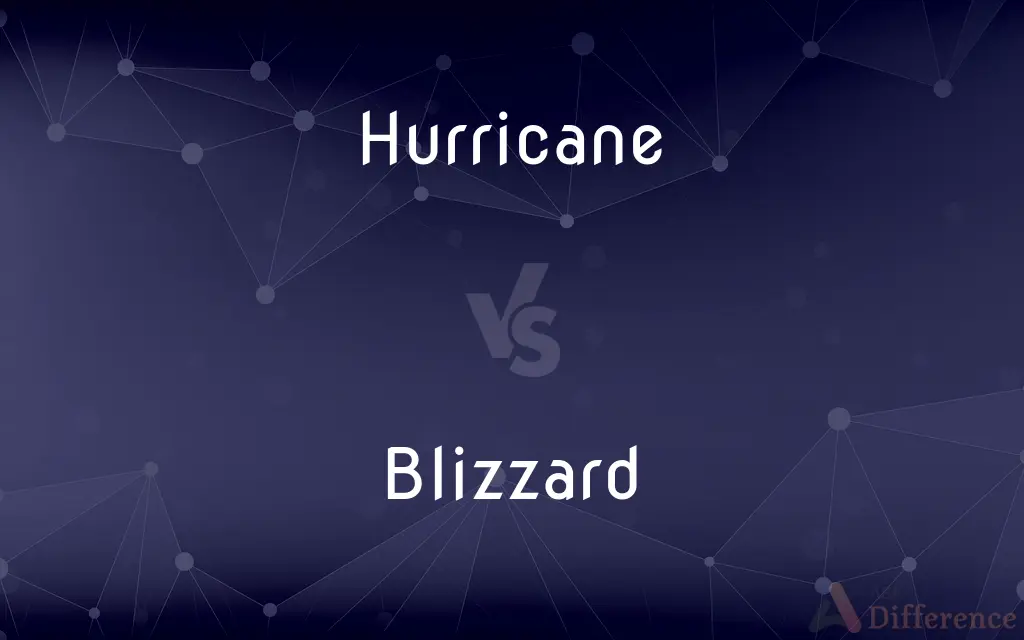Hurricane vs. Blizzard — What's the Difference?
By Urooj Arif & Fiza Rafique — Updated on April 15, 2024
Hurricane is a tropical storm with warm, moist air and winds exceeding 74 mph; blizzard involves cold air, strong winds, and heavy snow, impacting visibility and temperature.

Difference Between Hurricane and Blizzard
Table of Contents
ADVERTISEMENT
Key Differences
A hurricane is a powerful tropical storm characterized by strong winds of at least 74 mph and heavy rainfall, originating over warm ocean waters. On the other hand, a blizzard is a severe snowstorm with winds exceeding 35 mph, and visibility reduced to less than a quarter-mile for at least three hours due to falling or blowing snow.
Hurricanes typically form in tropical regions and rely on warm sea surface temperatures to fuel their energy. Whereas blizzards occur in colder climates and are driven by sharp temperature differences between colliding air masses.
The structure of a hurricane includes a well-defined eye, surrounded by the eyewall where the most intense weather occurs, including very strong winds and heavy rains. Blizzards, however, do not have an eye; their main hazard is reduced visibility and extreme cold, often accompanied by ice and freezing conditions.
Hurricanes can cause widespread devastation through high winds, storm surges, and flooding, affecting large coastal areas. In contrast, blizzards impact primarily through extreme cold and snow accumulation, leading to transportation disruptions and hazardous conditions, particularly over inland areas.
The seasonal timing also differs: hurricanes are most common from June to November in the Atlantic, aligning with warmer ocean temperatures. Blizzards are more frequent in the winter months in the northern hemisphere when temperature conditions are right for snow formation.
ADVERTISEMENT
Comparison Chart
Definition
A tropical cyclone with winds ≥ 74 mph.
A severe snowstorm with winds ≥ 35 mph.
Key Conditions
Warm ocean waters, low atmospheric pressure
Cold air, strong winds, heavy snow
Typical Duration
Hours to days
Hours to days
Main Hazards
High winds, heavy rain, flooding
Reduced visibility, extreme cold
Common Locations
Tropical oceanic regions
Northern hemisphere, cold regions
Compare with Definitions
Hurricane
A tropical storm with winds exceeding 74 mph.
The hurricane caused extensive damage along the coastline.
Blizzard
Can last for several hours or more, creating hazardous conditions.
The blizzard persisted for 36 hours, piling snow three feet high.
Hurricane
Can lead to storm surges and significant coastal flooding.
The storm surge during the hurricane inundated the city.
Blizzard
A severe snowstorm with winds over 35 mph and poor visibility.
The blizzard shut down highways and stranded motorists.
Hurricane
Characterized by a low-pressure center, high winds, and heavy rain.
Residents were evacuated as the hurricane approached.
Blizzard
Commonly occurs in cold regions during winter.
The annual blizzard in this region is a challenging ordeal.
Hurricane
Forms over warm ocean waters in tropical areas.
The hurricane gained strength as it moved over warm Atlantic waters.
Blizzard
Characterized by significant snowfall and blowing snow.
Visibility was near zero during the blizzard.
Hurricane
Often tracked by meteorologists to predict its path.
The hurricane’s path shifted overnight, prompting new warnings.
Blizzard
Requires emergency preparedness for cold and snow accumulation.
Residents stocked up on supplies ahead of the forecasted blizzard.
Hurricane
A severe tropical cyclone having winds greater than 64 knots (74 miles per hour; 119 kilometers per hour), originating in the equatorial regions of the Atlantic Ocean or Caribbean Sea or eastern regions of the Pacific Ocean, traveling north, northwest, or northeast from its point of origin, and usually involving heavy rains.
Blizzard
A blizzard is a severe snowstorm characterized by strong sustained winds of at least 56 km/h (35 mph) and lasting for a prolonged period of time—typically three hours or more. A ground blizzard is a weather condition where snow is not falling but loose snow on the ground is lifted and blown by strong winds.
Hurricane
A wind with a speed greater than 64 knots (74 miles per hour; 119 kilometers per hour per hour), according to the Beaufort scale.
Blizzard
A violent snowstorm with winds blowing at a minimum speed of 35 miles (56 kilometers) per hour and visibility of less than one-quarter mile (400 meters) for three hours.
Hurricane
Something resembling a hurricane in force or speed.
Blizzard
A very heavy snowstorm with high winds.
Hurricane
A severe tropical cyclone in the North Atlantic Ocean, Caribbean Sea, Gulf of Mexico, or in the eastern North Pacific off the west coast of Mexico, with winds of 119 km/h (74 miles per hour) or greater accompanied by rain, lightning, and thunder that sometimes moves into temperate latitudes.
Blizzard
A torrent; a superabundance
A blizzard of phone calls.
Hurricane
(meteorology) A wind scale for quite strong wind, stronger than a storm
Blizzard
A large snowstorm accompanied by strong winds and greatly reduced visibility caused by blowing snow.
Hurricane
"full—triple-full—full" – an acrobatic maneuver consisting of three flips and five twists, with one twist on the first flip, three twists on the second flip, one twist on the third flip
Blizzard
(figuratively) A large amount of paperwork.
Hurricane
A violent storm, characterized by extreme fury and sudden changes of the wind, and generally accompanied by rain, thunder, and lightning; - especially prevalent in the East and West Indies. Also used figuratively.
Like the smoke in a hurricane whirl'd.
Each guilty thought to me isA dreadful hurricane.
Blizzard
(figuratively) A large number of similar things.
A blizzard of political ads
Hurricane
A severe tropical cyclone usually with heavy rains and winds moving a 73-136 knots (12 on the Beaufort scale)
Blizzard
To fall in windy conditions.
Blizzard
A gale of piercingly cold wind, usually accompanied with fine and blinding snow; a furious blast.
Blizzard
A storm with widespread snowfall accompanied by strong winds
Blizzard
A series of unexpected and unpleasant occurrences;
A rash of bank robberies
A blizzard of lawsuits
Common Curiosities
How does a blizzard form?
Blizzards form when cold air lies below warmer air at high altitudes, combined with strong winds to lift moisture, resulting in heavy snow and reduced visibility.
What are the key differences in the conditions leading to hurricanes and blizzards?
Hurricanes require warm ocean temperatures and tropical conditions, while blizzards occur with cold air, strong winds, and sufficient moisture for snow.
What safety precautions should be taken for a hurricane versus a blizzard?
For hurricanes, evacuation and protection against wind and water are crucial; for blizzards, ensuring warmth, food, and clearing snow are key.
What is a hurricane?
A hurricane is a type of tropical cyclone characterized by low atmospheric pressure, strong winds, and heavy rain, forming over warm tropical waters.
How do governments typically respond to hurricanes?
Responses include emergency declarations, evacuations, and deploying rescue and aid organizations.
Can hurricanes and blizzards occur at the same place?
Rarely, as hurricanes occur in tropical regions and blizzards in colder, often inland, areas.
What impacts do hurricanes have on the environment?
Hurricanes can cause erosion, destroy habitats, and lead to long-term ecological changes.
What research is being done on hurricanes?
Research includes improving prediction models, understanding atmospheric conditions, and studying climate change impacts.
What are the economic impacts of blizzards?
Blizzards can disrupt commerce, lead to high cleanup costs, and cause significant economic disruptions, particularly in transportation.
Are hurricanes more destructive than blizzards?
Generally, hurricanes can be more destructive due to wind, water, and widespread impact, but blizzards also pose severe risks, particularly due to cold and isolation.
What are some misconceptions about blizzards?
A common misconception is that blizzards only involve snowfall, but the wind and visibility are defining factors.
How do meteorologists predict hurricanes and blizzards?
Hurricanes are tracked using satellite imagery and ocean buoys, while blizzards are predicted through meteorological models and radar.
What is the role of emergency services during a blizzard?
Emergency services focus on rescuing stranded individuals, clearing roads, and ensuring public safety.
How are blizzards and hurricanes similar?
Both can cause significant disruptions, require preparedness, and are tracked and predicted by meteorologists using advanced technology.
How can communities prepare for hurricanes?
By reinforcing structures, creating evacuation plans, and maintaining emergency supplies.
Share Your Discovery

Previous Comparison
Concise vs. Precise
Next Comparison
Anhydrous vs. MonohydrateAuthor Spotlight
Written by
Urooj ArifUrooj is a skilled content writer at Ask Difference, known for her exceptional ability to simplify complex topics into engaging and informative content. With a passion for research and a flair for clear, concise writing, she consistently delivers articles that resonate with our diverse audience.
Co-written by
Fiza RafiqueFiza Rafique is a skilled content writer at AskDifference.com, where she meticulously refines and enhances written pieces. Drawing from her vast editorial expertise, Fiza ensures clarity, accuracy, and precision in every article. Passionate about language, she continually seeks to elevate the quality of content for readers worldwide.














































